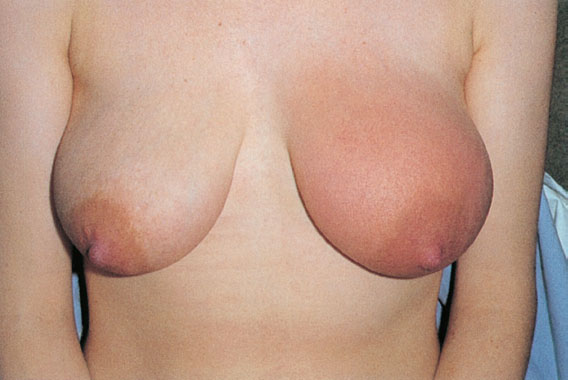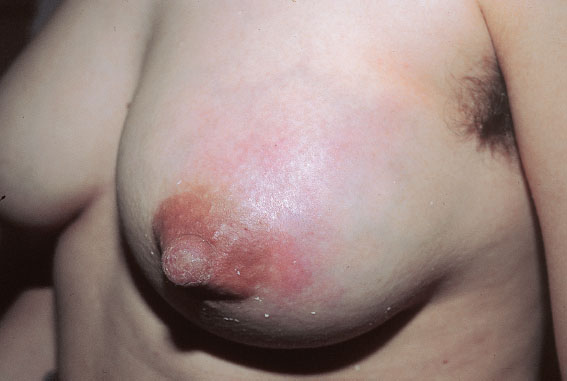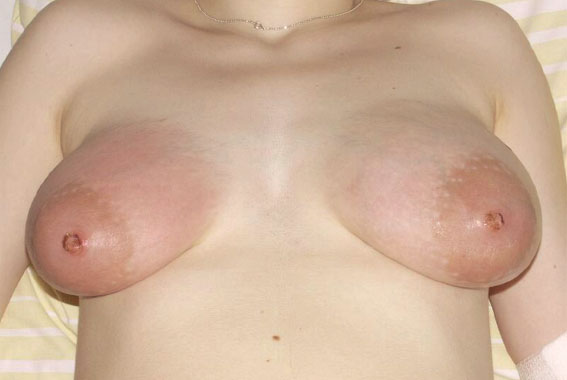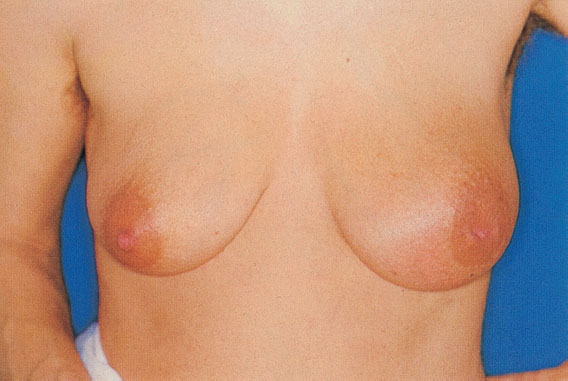10 | Inflammation of the Breast |
Mastitis
Mastitis is a mostly unilateral inflammation of the mammary gland, associated with redness, pain, and fever (Fig. 10.1). In addition to puerperal mastitis, which is well known during childbed, and nonpuperperal mastitis, which occurs independently of pregnancy and breast-feeding, there are a number of rare infections and inflammations of the breast that, in part, only affect the skin and its appendages.
Puerperal Mastitis 
Pathogen. Staphylococcus aureus is the pathogen in 95% of patients. Rarely is any other pathogen detected, such as Staphylococcus epidermidis, Streptococcus species, Proteus species, Escherichia coli, Klebsiella, and very rarely anaerobes or even Pseudomonas aeruginosa. It is questionable whether the latter bacteria are actually involved in causing the inflammation.
Frequency. About 1% of all puerpera suffer from mastitis. This figure may be higher or lower depending on whether retention of the milk is already classified as mastitis, or only the full-blown clinical picture with high fever or even abscess formation.
Transmission. In most cases, the pathogen is transmitted by the child’s mouth, which during the first days of life becomes increasingly colonized with microbes from the child’s surroundings. The infection is promoted through milk retention and formation of cracks in the region around the nipple.
It is very common that the milk becomes contaminated with the above-mentioned pathogens, although germ counts are usually in the lower range (< 104/mL). In about 80% of all breast-fed children, Staphylococcus aureus can be detected in the oral cavity after a week.
Retention of milk promotes intense microbial multiplication, thus causing clinically manifest mastitis in isolated cases.
Hematogenous infections with the above-mentioned pathogens are rare.
Clinical picture. The clinical picture may vary from a mild painful redness (Fig. 10.2) to a highly febrile, very painful inflammation of the breast. Only in rare cases are both breasts affected (Fig. 10.3):
 mostly moderate inflammation, rarely causing severe malaise
mostly moderate inflammation, rarely causing severe malaise
 shaking chills and fever above 39 °C are common
shaking chills and fever above 39 °C are common
 a mostly unilateral reddening associated with pain, hyperthermia, and induration.
a mostly unilateral reddening associated with pain, hyperthermia, and induration.

Fig. 10.1 Acute puerperal mastitis in a 21-year-old patient three weeks after delivery.

Fig. 10.2 Puerperal mastitis in a 28-year-old patient.

Fig. 10.3 Puerperal mastitis in a 20-year-old patient three weeks after delivery. Conspicuous signs are the bilateral inflammation and the mammillae with yellow crusts (Staphylococcus aureus).
Therapy. As in many areas of medicine, the recommendations are changing here.
Before the era of antibiotics, only topical treatment with alcohol packs and breast binding were available. Later, antibiotics have been added. With the introduction of prolactin inhibitors, it was initially hoped that one might rely completely on their effectiveness. Meanwhile, timely administration of antibiotics is regaining more importance. This clearly shows that there is a certain therapeutic range, especially because there is no clear dividing line between painful milk retention and infection.
Practical approach:
 drainage of the breast; the safest way to do this is with an electric milk pump (prescription)
drainage of the breast; the safest way to do this is with an electric milk pump (prescription)
 physical measures, such as a well-fitted nursing bra, breast binding, and cooling
physical measures, such as a well-fitted nursing bra, breast binding, and cooling
 prolactin inhibitors, such as bromocriptine and lisuride, quickly lead to relaxation and reabsorption, while inflammatory signs are reduced; low doses prevent weaning
prolactin inhibitors, such as bromocriptine and lisuride, quickly lead to relaxation and reabsorption, while inflammatory signs are reduced; low doses prevent weaning
 early administration of antibiotics—penicillinase-resistant penicillins, such as oxacillin and flucloxacillin, or better right away cephalosporins of the second generation, such as cefotiam (i.v.) or cefuroxime axetil (orally)—shortens the time of infection, while breast-feeding is hardly affected. In severe cases with fever, cephalosporin of the second generation should always be given immediately. In mild cases, healing may be achieved with Co-Trimoxazole. Clindamycin or a macrolide antibiotic are also an option
early administration of antibiotics—penicillinase-resistant penicillins, such as oxacillin and flucloxacillin, or better right away cephalosporins of the second generation, such as cefotiam (i.v.) or cefuroxime axetil (orally)—shortens the time of infection, while breast-feeding is hardly affected. In severe cases with fever, cephalosporin of the second generation should always be given immediately. In mild cases, healing may be achieved with Co-Trimoxazole. Clindamycin or a macrolide antibiotic are also an option
 close clinical monitoring
close clinical monitoring
 in severe cases, admission to a hospital.
in severe cases, admission to a hospital.

Fig. 10.4 Nonpuerperal mastitis in a 36-year-old patient, with diffuse redness and swelling of the breast and a retracted mammillae.
Many women with mastitis wish to continue breast-feeding, and there is nothing that advises against it. The dose and duration of any prolactin inhibitor need to be adjusted so that the flow of milk does not stop completely.
Antibiotics should only be administered as long as symptoms are present.
Abscess-forming Mastitis 
If treatment is too late or inadequate, the inflammation may advance to a point where conservative measures no longer bring healing or an abscess has already formed.
Blood flow to the breast can be improved by red light, which promotes healing or necrolysis of the focus of inflammation.
If an abscess is detected, the pus needs to be drained. This is now increasingly performed by puncturing the abscess cavity under ultrasonic guidance and antibiotic treatment. Good results have been reported with this method.
Stay updated, free articles. Join our Telegram channel

Full access? Get Clinical Tree


